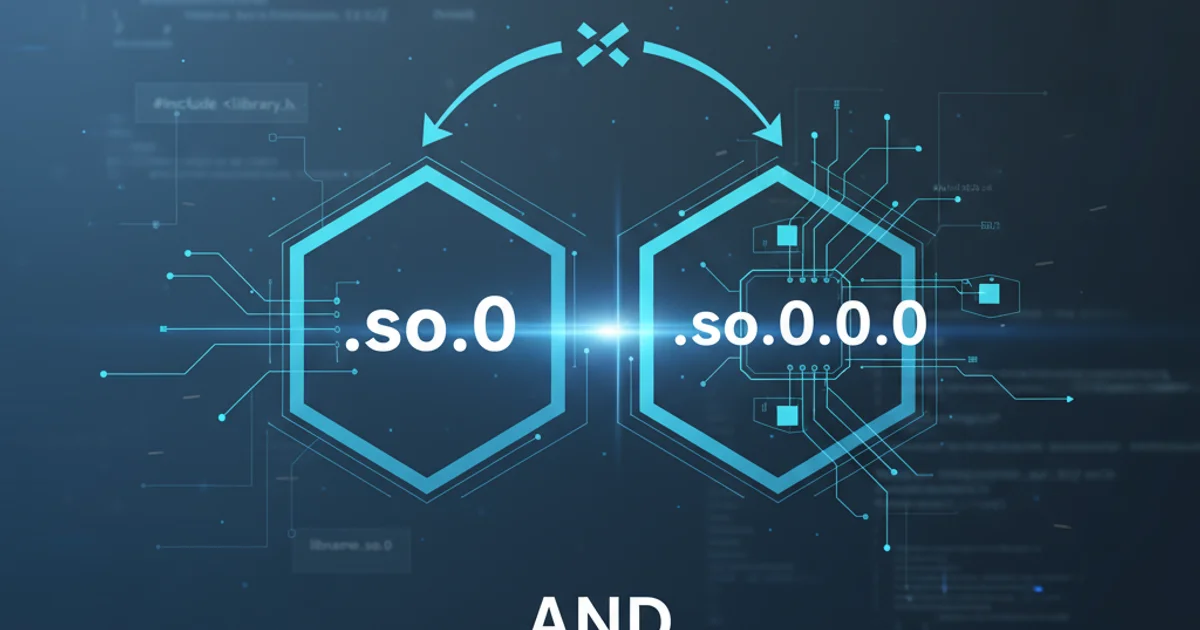difference between .so.0 and .so.0.0.0 files
Categories:
Understanding Shared Library Versioning: .so.0 vs .so.0.0.0

Explore the nuances of shared library naming conventions in Linux, specifically differentiating between major (.so.0) and minor (.so.0.0.0) version numbers and their implications for compatibility and system stability.
In the Linux ecosystem, shared libraries are fundamental components that allow programs to share common code, reducing memory footprint and facilitating updates. However, managing these libraries effectively requires a robust versioning scheme. You've likely encountered files like libfoo.so.0 and libfoo.so.0.0.0 and wondered about their precise differences and roles. This article delves into the intricacies of shared library versioning, explaining the significance of major, minor, and patch numbers, and how they impact application compatibility and system maintenance.
The Basics of Shared Library Naming
Shared libraries in Linux follow a specific naming convention to indicate their version and ensure proper linking. The general format is libNAME.so.MAJOR.MINOR.PATCH, where:
libis a standard prefix.NAMEis the library's actual name (e.g.,c,m,pthread)..soindicates it's a shared object.MAJORis the most critical part, representing the Application Binary Interface (ABI) version. Changes here usually mean backward incompatibility.MINORindicates new features or bug fixes that are backward compatible with the same major version.PATCH(orREVISION) signifies bug fixes that are also backward compatible and don't introduce new features.
flowchart TD
A[Application] --> B["libfoo.so (symlink to .so.MAJOR)"]
B --> C["libfoo.so.MAJOR (symlink to .so.MAJOR.MINOR.PATCH)"]
C --> D["libfoo.so.MAJOR.MINOR.PATCH (actual library file)"]
D --"Provides ABI"--> E[Functions & Data Structures]
subgraph Versioning Hierarchy
MAJOR[Major Version (ABI)]
MINOR[Minor Version (Features/Fixes)]
PATCH[Patch Version (Bug Fixes)]
end
MAJOR --> MINOR
MINOR --> PATCHShared Library Naming and Symlink Resolution
Understanding libfoo.so.0 (Soname)
The libfoo.so.0 file is typically a symbolic link, not the actual library file itself. It represents the soname (short for 'shared object name') of the library. The soname is embedded within the library file and is what the dynamic linker (ld.so) looks for when an application requests a library. It includes only the major version number because this is the crucial part for ABI compatibility.
When an application is compiled and linked against libfoo, it records libfoo.so.0 (or whatever the soname is) as the required library. At runtime, the dynamic linker searches for a file matching this soname. This allows for minor and patch updates to the library without requiring applications to be recompiled, as long as the ABI (major version) remains the same.
ls -l /lib/x86_64-linux-gnu/libc.so.6
readelf -d /lib/x86_64-linux-gnu/libc.so.6 | grep SONAME
Inspecting the soname of a shared library
Understanding libfoo.so.0.0.0 (Real Name)
The libfoo.so.0.0.0 file (or libfoo.so.MAJOR.MINOR.PATCH) is the real name of the shared library. This is the actual file containing the compiled code and data. It includes the full version number, reflecting all changes—major, minor, and patch.
When a new version of a library is installed, the package manager places the new real name file (e.g., libfoo.so.0.1.2) and then updates the libfoo.so.MAJOR symlink to point to this new real name. The libfoo.so symlink (used during compilation) might also be updated to point to the latest libfoo.so.MAJOR symlink, which in turn points to the latest real name.
ldconfig utility is crucial for managing shared library links. It creates the necessary symbolic links (.so and .so.MAJOR) and updates the dynamic linker's cache (/etc/ld.so.cache) after new libraries are installed or existing ones are updated.The Symlink Chain and Compatibility
The relationship between these files is typically managed through a chain of symbolic links:
libfoo.so: This symlink is used by the compiler/linker during the build process. It usually points to the latestlibfoo.so.MAJORavailable.libfoo.so.MAJOR: This is the soname symlink. It points to the actual library file with the full version number (e.g.,libfoo.so.MAJOR.MINOR.PATCH). This is what applications link against at runtime.libfoo.so.MAJOR.MINOR.PATCH: This is the actual shared library file.
This system ensures that:
- Applications compiled against a specific major version continue to work even if minor or patch versions are updated, as long as the ABI remains compatible.
- Multiple versions of the same library (with different major numbers) can coexist on the same system, allowing different applications to use the specific version they require.
graph TD
A["Application (at compile time)"] --> B["libfoo.so (development symlink)"]
B --> C["libfoo.so.MAJOR (soname symlink)"]
C --> D["libfoo.so.MAJOR.MINOR.PATCH (actual library file)"]
E["Application (at runtime)"] --> C
subgraph Library Installation
F["Package Manager installs libfoo.so.0.1.2"]
G["ldconfig updates symlinks"]
end
F --> G
G --> CShared Library Symlink Resolution and Runtime Linking
Practical Implications and Best Practices
Understanding this versioning scheme is vital for both developers and system administrators:
- For Developers: When developing libraries, increment the major version only when introducing ABI-breaking changes. For backward-compatible feature additions or bug fixes, increment the minor or patch version. When linking applications, link against the
libfoo.sosymlink, which will resolve to the correct soname. - For System Administrators: When updating libraries, ensure that the package manager correctly updates the symlinks. If you need to install multiple versions of a library, ensure they are placed in appropriate paths and that
ldconfigis run to update the linker cache. Use tools likelddto inspect which libraries an executable is linked against.
# Example: Listing shared libraries an executable depends on
ldd /bin/ls
# Example: Forcing ldconfig to update symlinks and cache
sudo ldconfig
Using ldd and ldconfig for library management